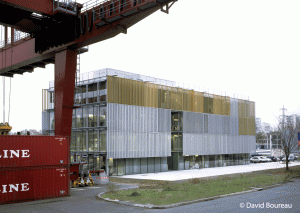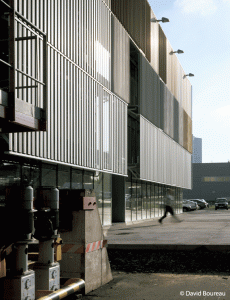Logistics centre for containers – France
The port of Gennevilliers, situated in the north of Paris, is one of the important inland ports of Ile-de-France. It is connected via the river Seine and several canals to the great container ports of Le Havre in France and Rotterdam in the Netherlands.
A few years ago, the port authority embarked on a major programme to modernize its infrastructure and buildings. They commissioned French architect Odile Decq to develop a masterplan and architects Ibos and Vitart are currently working on a large, 12000 m² warehouse project.
In addition, the port authority, decided to create a new Logistic Centre close to the container platform and the basins to improve container handling. The Austrian architect Dietmar Feichtinger, who heads a practice with offices in Vienna and in Paris, won the competition in 2001.
For Feichtinger, known in France mostly for his detailed work on bridges, like the pedestrian bridge in front of the National Library in Paris and the bridge for the historic Mont Saint-Michel in Normandy, the Logistics Centre is one of his first buildings in this country. The conceptual starting point for his design was the image of stacked containers. He is by no means the first architect to use this image, for the sea container has fascinated architects ever since its invention by Malcom McLean in 1956. But in this project, Feichtinger interprets the image as a method of rational organisation and, without taking the image too literally, manages to create an aesthetic that refers to the port’s architecture.
The simple, cubic volume of the building is structured by two vertical incisions, the longish entrance hall on the ground floor and two internal patios. On its four floors the building offers some 2000 square meters of office space. The ground floor is occupied by the container administration for the reception of the road hauliers. It is the only floor open to the public. On the top floor the director’s offices and a large conference room enjoy a view over the entire port while the two intermediate floors are occupied by general office spaces.
The architect designed the main facade with an inner skin out of large glass panels that envelop the whole building. A second, outer skin consists of vertical, swivelling blinds that shield users from direct sunlight. This protection envelops the upper three floors with the exception of the north elevation. The system for the outer skin of the building was developed by the architect in collaboration with the German company M&W. It is composed of 30- centimetre-wide slats assembled in rows of ten in a metal framework that is fixed to the concrete floors. The aluminium blinds are not completely opaque, but perforated on 40% of their surface to avoid hard shadows in the office spaces. Their metallic gold and silver are reminiscent of container colours, faded by long journeys.
A hydraulic system allows for individual control, so that users can adjust their section of the solar shading to provide whatever light intensity they need. The blinds also create a filter for the users, providing discretion and privacy within the harsh industrial environment, while maintaining a good visibility to the outside world.
Basically the building is a simple glass box, divided into office spaces. But it is this simplicity and rational organisation that reflects the demands of a Logistics Centre, while the outer system of vertical blinds gives the building a texture appropriate to the surrounding landscape.
Published in «A10» in Jul/Aug 2005






















